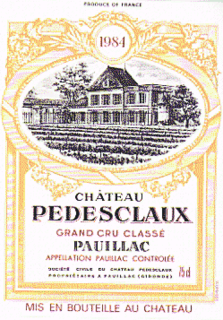
Château Pédesclaux is a winery in the Pauillac appellation of the Bordeaux region of France. The wine produced here was classified as one of eighteen Cinquièmes Crus in the Bordeaux Wine Official Classification of 1855.

Château Lagrange is a winery in the Saint-Julien appellation of the Bordeaux region of France, and is also the name of the red wine produced by this property. It is owned by the Japanese liquor giant Suntory. The wine produced here was classified as one of fourteen Troisièmes Crus in the historic Bordeaux Wine Official Classification of 1855.

Château Pontet-Canet is a winery in the Pauillac appellation of the Bordeaux wine region of France. Chateau Pontet-Canet is also the name of the red wine produced by this property. The wine produced here was classified as one of eighteen Cinquièmes Crus in the Bordeaux Wine Official Classification of 1855.
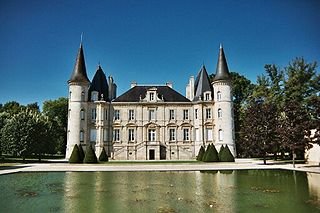
Château Pichon Longueville Baron or Château Longueville au Baron de Pichon-Longueville is a winery in the Pauillac appellation of the Bordeaux region of France. Château Pichon Longueville Baron is also the name of the red wine produced by this property. The wine produced here was classified as one of fifteen Deuxièmes Crus in the original Bordeaux Wine Official Classification of 1855.

Château Lynch-Moussas is a French winery in the Pauillac appellation of the Bordeaux region of France. Château Lynch-Moussas is also the name of the red wine produced by this property. The wine produced here was classified as one of eighteen Cinquièmes Crus in the Bordeaux Wine Official Classification of 1855.
Château Ducru-Beaucaillou is a winery in the Saint-Julien appellation of the Bordeaux region of France. Château Ducru-Beaucaillou is also the name of the red wine produced by this property. The wine produced here was classified as one of fifteen Deuxièmes Crus in the original Bordeaux Wine Official Classification of 1855.
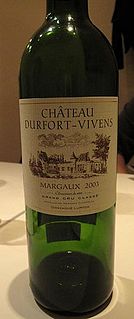
Château Durfort-Vivens is a winery in the Margaux appellation of the Bordeaux region of France. It is also the name of the red wine produced by this property. The wine produced here was classified as one of fifteen Deuxièmes Crus in the original Bordeaux Wine Official Classification of 1855.
Château Kirwan is a winery in the Margaux appellation of the Bordeaux region of France. The wine produced here was classified as one of fourteen Troisièmes Crus in the historic Bordeaux Wine Official Classification of 1855.

Château d'Issan is a castle and winery in the Margaux appellation of the Bordeaux region of France. The wine produced here was classified as one of fourteen Troisièmes Crus in the historic Bordeaux Wine Official Classification of 1855. The winery is under the proprietorship of Emmanuel Cruse, of the Cruse family. In February 2013, 50% of the estate was purchased by Jacky Lorenzetti, who also owns Château Pédesclaux in Pauillac & Chateau Lilian Ladouys in Saint-Estèphe.
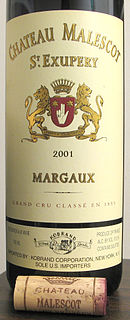
Château Malescot St. Exupéry is a winery in the Margaux appellation of the Bordeaux region of France. The wine produced here was classified as one of fourteen Troisièmes Crus in the historic Bordeaux Wine Official Classification of 1855. The vineyards are planted with 50% Cabernet Sauvignon, 35% Merlot, 10% Cabernet Franc and 5% Petit Verdot, at a density of 10,000 vines/hectare, with an average age of about 35 years. A second wine is also produced, La Dame de Malescot.
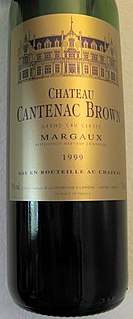
Château Cantenac-Brown is a winery in the Margaux appellation of the Bordeaux region of France. The wine produced here was classified as one of fourteen Troisièmes Crus in the historic Bordeaux Wine Official Classification of 1855. The Château has 118 acres (0.48 km2) planted with Cabernet Sauvignon, Merlot and Cabernet Franc. The Château produces a second wine labeled as Brio de Cantenac-Brown.
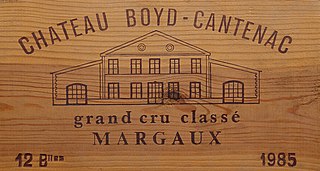
Château Boyd-Cantenac is a winery in the Margaux appellation of the Bordeaux region of France. The wine produced here was classified as one of fourteen Troisièmes Crus in the historic Bordeaux Wine Official Classification of 1855. The vineyard, totalling 46 acres (190,000 m2), is planted with Cabernet Sauvignon, Merlot, Cabernet Franc, and Petit Verdot and abuts other Margaux châteaux, including Château Brane-Cantenac and Château Kirwan. Producing annually 5,000-6,000 cases, Boyd Cantenac makes in addition to its Grand vin, a second wine under the labels Jacques Boyd and Josephine de Boyd.
Château Duhart-Milon, previously also Château Duhart-Milon-Rothschild, is a winery in the Pauillac appellation of the Bordeaux region of France. The wine produced here was classified as one of ten Quatrièmes Crus Classés in the historic Bordeaux Wine Official Classification of 1855. The Château has 175 acres (0.71 km2) planted with Cabernet Sauvignon, Merlot and Cabernet Franc. The Château produces a second wine under the label Moulin de Duhart. It is managed by Charles Chevallier, general manager at Château Lafite Rothschild.

Château La Tour Carnet is a Bordeaux wine estate in the appellation Haut-Médoc. The wine produced here was classified as one of ten Quatrièmes Crus in the historic Bordeaux Wine Official Classification of 1855, at the time known by the name of Carnet.
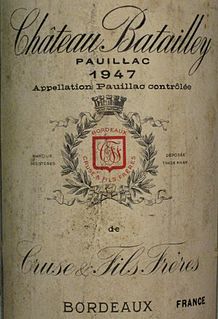
Château Batailley is a winery in the Pauillac appellation of the Bordeaux region of France. The wine produced at the estate was classified as one of eighteen Cinquièmes Crus in the Bordeaux Wine Official Classification of 1855.

Château Haut-Batailley is a winery in the Pauillac appellation of the Bordeaux region of France. The wine produced here was part of the property that was classified as one of eighteen Cinquièmes Crus in the Bordeaux Wine Official Classification of 1855.

Château Dauzac is a winery in the Margaux appellation of the Bordeaux region of France, in the commune of Labarde. The wine produced here was classified as one of eighteen Cinquièmes Crus in the Bordeaux Wine Official Classification of 1855. Since 1988, the estate has belonged to the insurance company MAIF, but is managed by the André Lurton group. In 2004, his daughter Christine Lurton-Bazin de Caix took charge of the property.
Château d'Armailhac, previously named Château Mouton-d'Armailhacq, Château Mouton-Baron Philippe, Mouton Baronne and Château Mouton-Baronne-Philippe (1979–1988), is a winery in the Pauillac appellation of the Bordeaux region of France. The wine produced here was classified as one of eighteen Cinquièmes Crus in the Bordeaux Wine Official Classification of 1855.
Château du Tertre, or Le Tertre, is a winery in the Margaux appellation of the Bordeaux region of France, in the commune of Arsac. The wine produced here was classified as one of eighteen Cinquièmes Crus in the Bordeaux Wine Official Classification of 1855.

Château Saint-Pierre is a winery in the Saint-Julien appellation of the Bordeaux region of France. The wine produced here was classified as one of ten Quatrièmes Crus Classés in the historic Bordeaux Wine Official Classification of 1855.






















